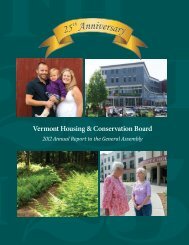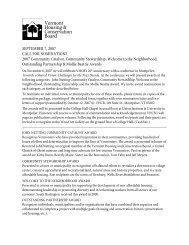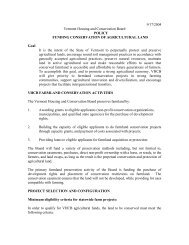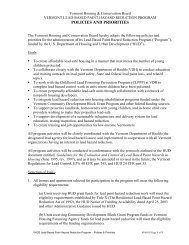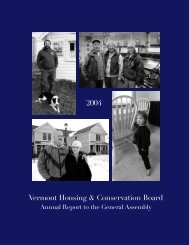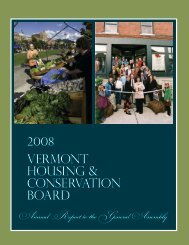Vermont Housing Conservation Board 2005 - Vermont Housing and ...
Vermont Housing Conservation Board 2005 - Vermont Housing and ...
Vermont Housing Conservation Board 2005 - Vermont Housing and ...
You also want an ePaper? Increase the reach of your titles
YUMPU automatically turns print PDFs into web optimized ePapers that Google loves.
Bob Eddy photos<br />
Engl<strong>and</strong> what became known as the<br />
“American system” of precision manufacturing.<br />
The techniques <strong>and</strong> expertise<br />
developed at Robbins & Lawrence gave<br />
rise to the Industrial Revolution. From<br />
the first manufacture of guns, sewing<br />
machines, typewriters, <strong>and</strong> railroad<br />
cars until today, virtually all important<br />
consumer products have been manufactured<br />
of interchangeable parts.<br />
Windsor became the birthplace<br />
of America’s Precision Valley, from<br />
here through Springfield along the<br />
Connecticut River. Its machine-tool<br />
industry, so vital to the Allied success<br />
in World War II, is virtually gone<br />
today — but its importance lives on.<br />
“It’s interesting, geographically: At<br />
one end of Windsor there’s the Constitution<br />
House [cradle of the <strong>Vermont</strong><br />
Constitution], <strong>and</strong> on the other end<br />
is the American Precision Museum,”<br />
reflects Bill Ballantyne, chair of the<br />
Windsor Downtown <strong>Board</strong>. “They<br />
represent the two major birthplace<br />
events that play a significant role in<br />
Windsor’s identity.”<br />
The Precision Museum houses an<br />
amazing collection of 19th century<br />
machine tools, set up for interactive<br />
display — but the building’s own<br />
deterioration threatened its survival.<br />
Having won a 200,000 Save America’s<br />
Treasures grant, provided through<br />
a partnership of federal agencies,<br />
the museum brought in funds from<br />
VHCB, the Preservation Trust of<br />
<strong>Vermont</strong>, several foundations, <strong>and</strong><br />
individual donors to complete Phase I<br />
of a much-needed restoration project<br />
this year.<br />
Phase I installed a new slate roof<br />
that matched the deteriorated original,<br />
<strong>and</strong> renovated 70 of the 166 historic<br />
wood windows. Phase II targets the remaining<br />
windows, structural elements,<br />
<strong>and</strong> masonry restoration, along with<br />
probable safety improvements.<br />
“This year we’re going to be launching<br />
a new initiative,” says museum<br />
Director Ann Lawless, “to focus on<br />
developing a coherent education<br />
program that’s based on what teachers<br />
need from us, <strong>and</strong> that references the<br />
<strong>Vermont</strong> <strong>and</strong> New Hampshire educational<br />
st<strong>and</strong>ards.”<br />
“There are a lot of really good ideas<br />
out there,” adds Trustee Gilbertson.<br />
Other Historic<br />
Preservation Projects<br />
Jamaica Town Hall<br />
The Town Hall Restoration<br />
Committee is leveraging a VHCB<br />
grant with substantial locally raised<br />
funds to restore the 1851-vintage<br />
Town Hall, located on Route 30<br />
in the heart of the village <strong>and</strong><br />
identifi ed in the town plan as<br />
Jamaica’s “cultural, civic, <strong>and</strong><br />
religious center.” VHCB funding<br />
will enable the restoration of<br />
historic features, both external <strong>and</strong><br />
structural. A historic preservation<br />
easement will be held by VHCB<br />
<strong>and</strong> the Preservation Trust of<br />
<strong>Vermont</strong>.<br />
Roxbury Depot<br />
In Roxbury, VHCB funding helped<br />
make possible the restoration<br />
<strong>and</strong> rehabilitation of the Roxbury<br />
Depot, a town-owned building on<br />
Route 12A that is the community’s<br />
only public meeting space for<br />
town-related business. The town<br />
moved the building — originally<br />
one of <strong>Vermont</strong>’s fi rst railroad<br />
stations — onto adjacent, townowned<br />
l<strong>and</strong>, restored the depot<br />
inside <strong>and</strong> out, added a small,<br />
“historically sensitive” addition,<br />
<strong>and</strong> made the building wheelchairaccessible.<br />
37



